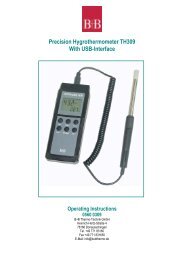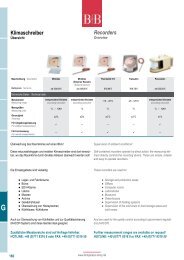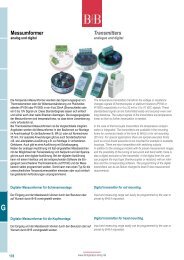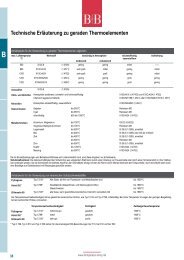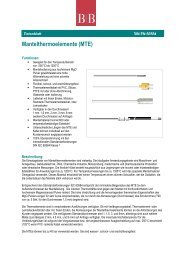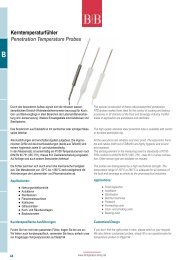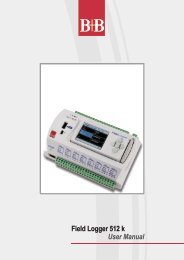B - Temperatur-Shop
B - Temperatur-Shop
B - Temperatur-Shop
You also want an ePaper? Increase the reach of your titles
YUMPU automatically turns print PDFs into web optimized ePapers that Google loves.
RS-485<br />
A recommended standard developed by EIA that is an improvement over RS-422 in that<br />
it allows an increase in the number of receivers and transmitters permitted on the line.<br />
RTD resistance temperature device<br />
A contact measurement device whose resistance varies with temperature.<br />
S<br />
Sample hold<br />
A temperature taken from a target and displayed or held for a set period of time or until<br />
the next external reset occurs.<br />
Scatter<br />
Radiant energy reaching the detector of an instrument from the background other than<br />
that which is reflected from the target.<br />
Set point<br />
Process or measurement variable setting which when crossed by the measured value will<br />
trigger an event and/or cause a relay to change state.<br />
Shock test<br />
An impact test where an object or test unit is subjected to an impulsive force which is<br />
capable of exciting mechanical resonances of vibration.<br />
Signal processing<br />
Manipulation of temperature data for purposes of enhancing the data. Examples of signal<br />
processing functions include Peak Hold, Valley Hold, and Averaging.<br />
Silicon (Si) detector<br />
A photon detector used in measurement of high temperatures.<br />
Size-of-source efect<br />
The effect by which the energy collected by, and temperature reading of, an instrument<br />
continues to increase as the size of a target increases beyond the field-of-view of the<br />
instrument. It is caused by two occurrences: the remaining energy above the percentage<br />
used to define location and scattering of radiation as it enters the instrument such<br />
that energy from outside the FOV of the instrument enters it. The existence of this effect<br />
means that the accuracy of the instrument may be affected by targets that are too large<br />
as well as two small. This effect is also called Target Size Effect. [ASTM STP 895]<br />
Slope<br />
The ratio of the emissivities for the two spectral bands of a 2-color radiometer. The emissivity<br />
of the shorter wavelength band is divided by the emissivity of the longer wavelength<br />
band. Slope can be greater than, equal to, or less than unity. Slope accounts for materials<br />
where emissivity varies with wavelength.<br />
Specific humidity<br />
The specific humidity is the ratio of the mass of water vapour to the total<br />
mass of the humid gas.<br />
Spectral filter<br />
An optical or infrared element used to spectrally limit the transmission of radiant energy<br />
reaching an instrument?s detector.<br />
Spectral range<br />
The wavelength region in which the IR Thermometer is sensitive.<br />
Spot<br />
The diameter of the area on the target where the temperature determination is made.<br />
The spot is defined by the circular aperture at the target which allows typically 90 % of<br />
the IR energy from the target to be collected by the instrument. See also Size-of-Source<br />
Effect.<br />
Stare or lag<br />
A saturation effect whereby the signal from an instrument endures beyond the response<br />
time after the target has been removed from the field of view. Can be caused by exposing<br />
the sensor to a target of high temperature for an extended period. The effect is<br />
expressed as the increase in response time required for the sensor to return to within<br />
5 % of the correct reading.<br />
Storage temperature<br />
The ambient temperature range an instrument can survive in a non-operating Range<br />
mode and perform within specifications when operated.<br />
T<br />
Target<br />
The object upon which the temperature is determined.<br />
Target size effect<br />
See Size-of-Source Effect.<br />
Teflon®<br />
Teflon® is a brand name and a registered trademark of DuPont.<br />
<strong>Temperatur</strong>e<br />
A property of an object which determines the direction of heat flow when the object is<br />
placed in thermal contact with another object (i.e., heat flows from a region of higher<br />
temperature to one of lower temperature).<br />
<strong>Temperatur</strong>e coefficient<br />
The change in accuracy of an instrument with changes in ambient temperature from<br />
that at which the instrument was calibrated. Usually expressed as the percent change in<br />
accuracy (or additional error in degrees) per change in ambient temperature. For a rapid<br />
change in ambient conditions, refer to Thermal Shock.<br />
<strong>Temperatur</strong>e resolution<br />
The minimum simulated or actual change in target temperature that gives a usable<br />
change in output and/or indication.<br />
Temporal drift<br />
See <strong>Temperatur</strong>e Coefficient.<br />
Test temperature<br />
The test temperature, Tt, is the gas temperature at the measuring location.<br />
Test pressure<br />
The test pressure, Pt, is the total pressure in the gas at the measuring<br />
location. The specification defines it as the absolute pressure against<br />
vacuum.<br />
www.temperatur-shop.de 217






